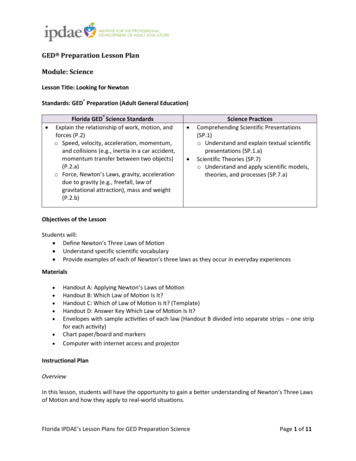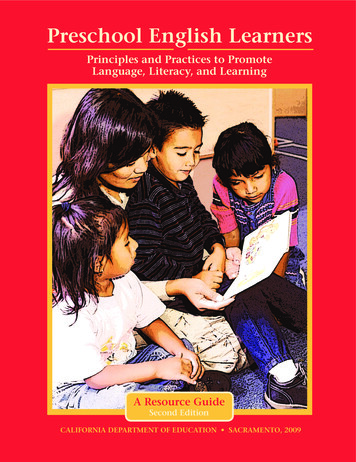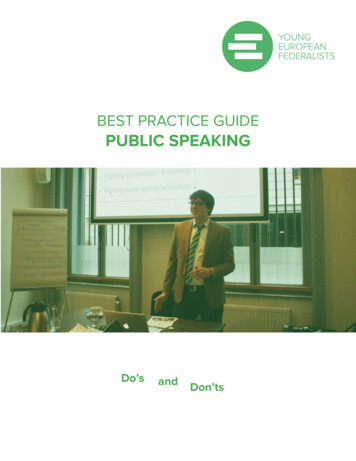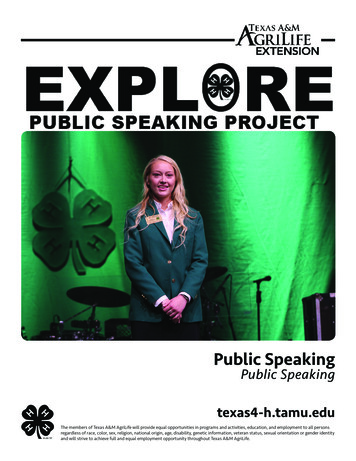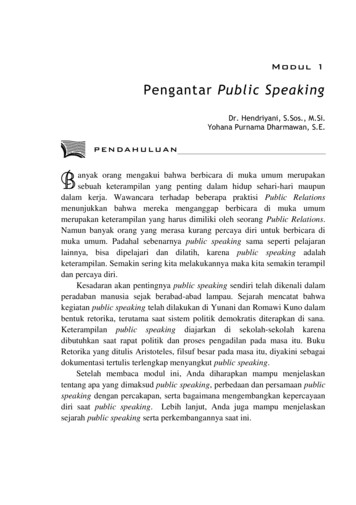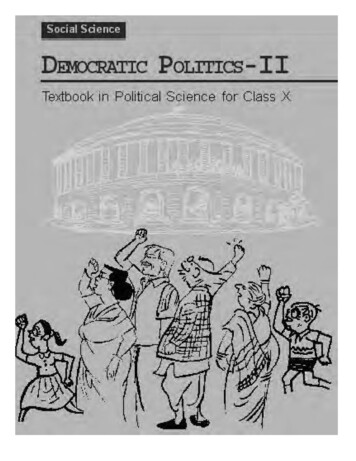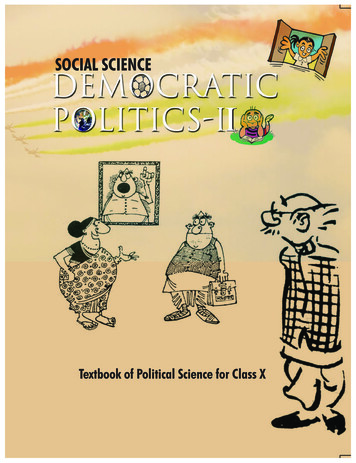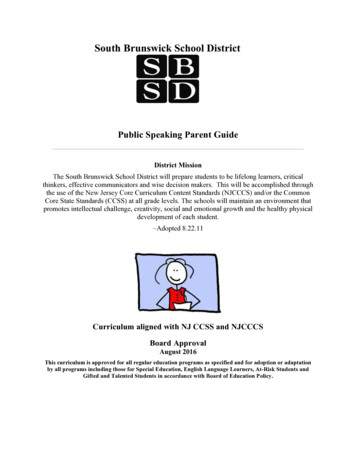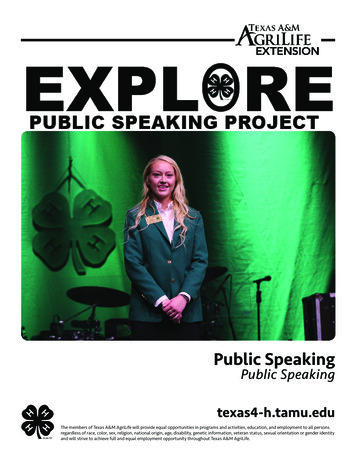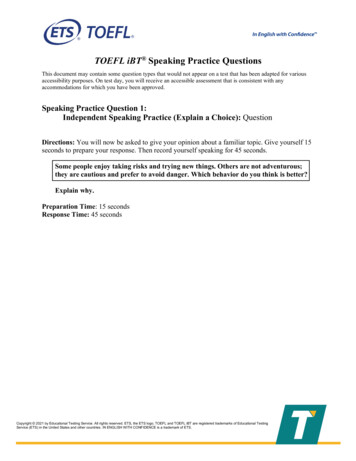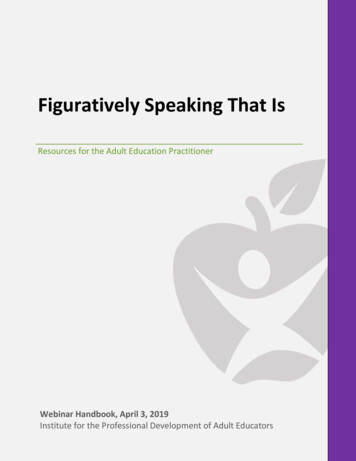
Transcription
Figuratively Speaking That IsResources for the Adult Education PractitionerWebinar Handbook, April 3, 2019Institute for the Professional Development of Adult Educators
RESOURCES FOR THE ADULT EDUCATION PRACTITIONERFiguratively Speaking That IsRod Duckworth, ChancellorCareer and Adult Education, Department of EducationCarol Bailey, DirectorAdult EducationJune Rall, Director of IPDAETamara Serrano, Project Support Specialist for IPDAEResources Developed and Designed ByBonnie Goonen, National Consultant for Florida IPDAEThis training event is supported with federal funds asappropriated to the Florida Department of Education,Division of Career and Adult Education for the provisionof state leadership professional development activities.Institute for the Professional Development of Adult Educators3209 Virginia Avenue - Fort Pierce, FL 34981Phone 772-462-7409 E-mail info@floridaipdae.org
Table of ContentsGuiding Questions . 1College and Career Readiness Standards – Figurative Language . 2Common Types of Figurative Language . 3The Elements of Figurative Language . 5Figurative Language Match . 6Matching Types of Figurative Language in Literary Passages . 8Figurative Language in Music and Poetry . 10Finding Figurative Language . 11Figuratively Speaking. 12Frayer Model – Figuratively Speaking! . 13Figurative Language Learning Log . 14Websites . 15Understanding Figurative Language . 16
Guiding QuestionsThink about the following guiding questions as you participate in today’s session.Write down your thoughts and be prepared to share your ideas.Slide(s)49101517-1820-2629-3337Guiding QuestionsThink about what you wantto take-away from thissession.Why do you need to teachfigurative language?What is the differencebetween literal andfigurative language andfigure of speech?Which was the most difficultcartoon for you to identifythe figurative languagedevice used? Why?What’s one take-away thatyou think is important fromthe research?What are the four steps inteaching figures of speech?What is your favoriteresource for teachingfigurative language? Why?Share the one thing that youfound most useful from thissession.1My Thoughts
College and Career Readiness Standards – Figurative LanguageCCR.RE.ABE.4: Interpret words and phrases as they are used in a text, including determining technical,connotative, and figurative meanings, and analyze how specific word choices shape meaning or tone.(Apply this standard to texts of appropriate complexity as outlined by Standard 10.)NRS Level 1NRS Level 2NRS Level 3NRS Level 4GE: 0.0–1.9GE: 2.0–3.9GE: 4.0–5.9GE: 6.0–8.94.1. Ask and answerquestions to helpdetermine or clarify themeaning of words andphrases in a text.4.2. Determine themeaning of generalacademic and domainspecific words andphrases in a textrelevant to a topic orsubject area.4.3. Determine themeaning of generalacademic and domainspecific words andphrases in a textrelevant to a topic orsubject area.4.4. Determine themeaning of words andphrases as they areused in a text, includingfigurative, connotative,and technicalmeanings; analyze theimpact of a specificword choice onmeaning and tone.a) Determine themeaning of words andphrases as they areused in a text, includingfigurative language suchas metaphors andsimiles.2
Common Types of Figurative LanguageThere are many, many types of figures of speech that can be involved in figurativelanguage. Some of the most common are:Metaphor: A figure of speech that makes a comparison between two unrelatedthings by stating that one thing is another thing, even though this isn't literally true.For example, the phrase "her lips are a blooming rose" obviously doesn't literallymean what it says—it's a metaphor that makes a comparison between the red beautyand promise of a blooming rose with that of the lips of the woman being described.Simile: A simile, like a metaphor, makes a comparison between two unrelated things.However, instead of stating that one thing is another thing (as in metaphor), a similestates that one thing is like another thing. An example of a simile would be to say"they fought like cats and dogs."Oxymoron: An oxymoron pairs contradictory words in order to express new orcomplex meanings. In the phrase "parting is such sweet sorrow" from Romeo andJuliet, "sweet sorrow" is an oxymoron that captures the complex and simultaneousfeelings of pain and pleasure associated with passionate love.Hyperbole: Hyperbole is an intentional exaggeration of the truth, used to emphasizethe importance of something or to create a comic effect. An example of a hyperboleis to say that a backpack "weighs a ton." No backpack literally weighs a ton, but to say"my backpack weighs ten pounds" doesn't effectively communicate how burdensomea heavy backpack feels.Personification: In personification, non-human things are described as having humanattributes, as in the sentence, "The rain poured down on the wedding guests,indifferent to their plans." Describing the rain as "indifferent" is an example ofpersonification, because rain can't be "indifferent," nor can it feel any other humanemotion.Idiom: An idiom is a phrase that, through general usage within a particular group orsociety, has gained a meaning that is different from the literal meaning of the words.The phrase "it's raining cats and dogs" is known to most Americans to mean that it'sraining hard, but an English-speaking foreigner in the United States might find thephrase totally confusing.Onomatopoeia: Onomatopoeia is a figure of speech in which words evoke the actualsound of the thing they refer to or describe. The “boom” of a firework exploding, the“tick tock” of a clock, and the “ding dong” of a doorbell are all examples ofonomatopoeia.3
Alliteration: In alliteration, the same sound repeats in a group of words, such as the“b” sound in: “Bob brought the box of bricks to the basement.” Alliteration usesrepetition to create a musical effect that helps phrases to stand out from thelanguage around them.Assonance: The repetition of vowel sounds repeat in nearby words, such as the "ee"sound: "the squeaky wheel gets the grease." Like alliteration, assonance usesrepeated sounds to create a musical effect in which words echo one another.Imagery: The use of figurative language to represent objects, actions, and ideas insuch a way that it appeals to our physical senses. “It was dark and dim in the forest” isan example where the words “dark” and “dim” are visual images. Imagery createsvisual representations, such as mental pictures.Irony: A figure of speech in which words are used in such a way that their intendedmeaning is different from the actual meaning of the words. “What a great idea” mayactually mean the idea is not great at all. Irony conveys the difference between howthings seem and reality.4
The Elements of Figurative LanguageGrammar is the structure of language. It includes the sounds, words, syntax, andsemantics of language. Rhetoric is what people do with language. It includes thewords that they select, how they structure phrases, and how they make things standout and be noticed. Style is the pattern of choices that an individual makes whenhe/she writes. Figurative language is used purposefully to distort language to makethe reader think about what the writer is trying to tell them. Figurative language isenjoyed by some people and disliked by others – usually those who just can’t get pastthe literal meaning and use of words. These people often dislike poetry because theyjust can’t “get” the meaning of the figurative language expressions that are used.Figurative language is not intended to be interpreted in a literal sense. Appealing tothe imagination, figurative language provides new ways of looking at the world.Figurative language compares two things that are different in enough ways so thattheir similarities, when pointed out, are interesting, unique, and/or surprising.Figurative language can be 1) thought provoking constructions or 2) clevermanipulations. Those of the first type would include the more common kinds offigurative language that people know, including simile, metaphor, symbol, and irony.These can require some careful reading and, sometimes, study to get the point thewriter is trying to make. The second kind of figurative language is more like the “pettricks” made famous by David Letterman. They are cute and more immediatelyunderstood, but they have little lasting effect.Remember, figurative language is a way to compare and contrast. When somelanguage can’t be taken literally, it forces people to compare what they have withwhat it might have been. Thus, we get two sets of meaning. Each form of figurativelanguage approaches the comparison differently.straight comparisoncompare A and BsimileA is like/as BmetaphorA is BsymbolA is represented by BironyA is not BAdapted from English 201 – Figurative Language, Milwaukee Area Technical College.Retrieved from the World Wide Web at: tm.5
Figurative Language Match1. Cut the cards apart.2. Have students match the term with the correct definition and example.3. Have students create their own examples to share.AlliterationRepeated consonantsounds occurring atthe beginning of wordsor within wordsPersonificationA figure of speechThe wind whisperedwhich gives thesoftly through thequalities of a person to trees.an animal, an object,or an ideaOnomatopoeiaThe use of words thatmimic soundsThe explosion wentBBOOOOOOMMMMMMM!!MetaphorTwo things arecompared withoutusing “like” or “as”The children were busybees.SimileA comparison between She is as sweet astwo relatively unlikecandy.things using the words“like” or “as”6Wide eyed andwondering, we waitedfor the others toawaken.
IdiomA catchy phrase notmeant to be takenliterally or word forwordHe’s got a chip on hisshoulder.HyperboleAn exaggeratedstatement used toheighten effect andemphasize a pointShe’s said so onseveral millionoccasions!UnderstatementThe opposite ofThis won’t hurt a bit.hyperbole, anexpression with lessstrength than expectedImageryWords that createThe fresh and juicyvisual representations/ orange is very cold andmental pictures ofsweet.ideas in our mind7
Matching Types of Figurative Language in Literary PassagesPrint the following and then cut out the excerpts and literary devices. See if students canmatch the excerpt to the correct literary device.ALLITERATIONThe repetition of similar sounds,usually consonants, in a group ofwords.IMAGERYWords or phrases that createpictures or images in thereader’s mind.“Doubting, dreaming dreams no mortal ever dared todream before.”The Raven – Edgar Allan PoeThe day is over quietly spent,The sky is ablaze with colors you've sent,The bright oranges and redsThe subtle blues,Harkens me to hear the news.Alicia Bechtel aka ChiariMETAPHORA figure of speech that makes acomparison between two thingswhich are basically dissimilarONOMATOPOEIAThe use of a word whose soundin some degree imitates orsuggests its meaning.OXYMORONA figure of speech that combinesopposite or contradictory ideasor terms.“Life's but a walking shadow, a poor playerThat struts and frets his hour upon the stage and thenis heard no more. . .”William Shakespeare"The fire crackled and the popcorn popped."“Sweet sorrow, wise fool, honest thief.”8
PERSONIFICATIONGiving animals, objects, or ideashuman characteristics such asemotion.SARCASMA form of sneering criticism inwhich disapproval is oftenexpressed as ironic praise.SIMILEA figure of speech comparingtwo essentially unlike thingsthrough the use of a specificword of comparison, such as likeor as.SYMBOLSomething that represents morethan what it is in a literal sense."The fog crept in on little cat feet."Carl SandburgJamison was walking away from the counter andsuddenly dropped his lunch tray. A stranger at thenext table looked up and said, "Well, that was reallyintelligent."“Higher still and higherFrom the earth it springsLike a cloud of fire To a Skylark – Percy Bysshe Shelley“The American flag”9
Figurative Language in Music and PoetryTeach students common types of figurative language, such as metaphors, similes,onomatopoeia, etc., through the use of songs. Provide students with different typesof lyrics from songs. Have the students identify the different types of figurativelanguage used by each of the composers. The following is one example: "The River"by Garth Brooks."The River" by Garth BrooksYou know a dream is like a river, ever changing as it flows.And a dreamer's just a vessel that must follow where it goes.Trying to learn from what's behind you and never knowing what's in storemakes each day a constant battle just to stay between the shores.And I will sail my vessel 'til the river runs dry.Like a bird upon the wind, these waters are my sky.I'll never reach my destination if I never try,So I will sail my vessel 'til the river runs dry.Too many times we stand aside and let the water slip away.To what we put off 'til tomorrow has now become today.So don't you sit upon the shore and say you're satisfied.Choose to chance the rapids and dare to dance the tides.ChorusThere's bound to be rough waters, and I know I'll take some falls.With the good Lord as my captain, I can make it through them all.Chorus-Poetic devises used in “The River” include: simile, metaphor, alliteration, hyperbole,couplet, personification.10
Finding Figurative LanguageUse this sheet to look for figurative language in different forms of media(newspapers, magazines, television, website articles, movies, songs, etc.)MediumExample11Device
Figuratively SpeakingAs you read through the text, look for examples of figurative language and write them in theorganizer below. Then, think about what the phrase from the text means and why the author mayhave included it.Example from TextType(circle poeiaImageryAlliterationWhat does it mean?12Why did the authorinclude it in the text?
Frayer Model – Figuratively Speaking!Diagram a Frayer’s Model for the identified term (simile, metaphor, personification, idiom,hyperbole, understatement). Place your term in the middle. In the top left corner, write yourdefinition. In the bottom left corner, give 3 examples. In the right bottom corner, give 3 nonexamples. In the top right corner, give an illustration of the term or one of your ple13
Figurative Language Learning LogFigurative Language Learning LogFigurativeLanguageLiteral Meaning14IntendedMeaningConnection toReal Life
WebsitesFigurative Language VideosFlocabulary. Figurative Language. e/Literary Devices in Pop Culture.https://www.youtube.com/watch?time continue 25&v U pxfifB6CoFigurative Language Raphttps://www.youtube.com/watch?v Y0kYzRU46Xs&feature youtu.beFigurative Language WorksheetsE-Reading. Figurative language overview and figurative-language-lesson/Eye on Idioms. Interactive tool from es/resources/interactives/idioms/Figurative Language Website Lessons in PowerPoint PresentationFigurative Language – Similes and Metaphors. Lesson/Preview/48971Magical Musical Tour: Using lyrics to teach literary ile/Teach/LessonPlans/Lesson MagicMusicTour.pdfMrs. Thomas Figurative Language tive-language-gameFigurative Language Gameshttps://ams.usd385.org/287579 4Figurative Language in Nonfiction lessons/ABE/Reading Lesson Plans/Figurative Language in Informational Text/Figurative Language in Informational Text.pdfFlorida IPDAE. http://www.floridaipdae.org/15
Understanding Figurative LanguageLITERAL LANGUAGELiterally: refers to the “literal” or dictionary definition of a word or wordsExample: Travis is an extremely strong young man.METAPHORA metaphor is when you compare thingsthat are essentially not alike.Print Media Example:Think about this Why does this ad for Geico Insurance usethe slogan “So easy a caveman can do it?”Do you think that a consumer needsspecial skills to apply for Geico Insurance?SYMBOLISMSymbolism occurs when you use a nounwith a particular meaning to representsomething different.Print Media Example:Think about this Why is champion boxer Oscar de la Hoyasporting the American flag with his milkmustache? What is the significance?SIMILEA simile is similar to a metaphor. Thisdifference is that a simile uses the words“like” or “as”.Print Media Example:Think about this Why does this car plate for Chevy trucks usethe slogan “Like a Rock!” What is theintended association between a Chevy truckand a rock?ONOMATOPOEIAOnomatopoeia is you name an action byimitating the sound that is associated with it.Print Media Example:Think about this Why does the box of Rice Krispies alwaysfeature the words “snap”, “crackle”, and“pop?” What is the effect gained by usingthese words repeatedly?FIGURATIVE LANGUAGEFiguratively: refers to a figure of speech or an interpretation of the words as theyare being used. You have to figure out the meaning of the words.Example: Travis is as strong as an ox.PERSONIFICATIONPersonification is when you give human-likequalities to something that is not human.HYPERBOLEA hyperbole is an exaggeration. It is usuallyused in a humorous way.Print Media Example:Print Media Example:Think about this How are M & M candies being portrayedhere? Does it look like they are acting likehuman beings?Think about this When you think about mints, do think aboutthem as being physically strong? Why arethese mints packaged in a metal box? Whatis your interpretation of this?ALLITERATIONIDIOMAlliteration is the repetition of the samesound at the beginning of words that areadjacent or closely connected.Print Media Example:An idiom is an expression that is used by agroup of people that is understood only bycommon use.Print Media Example:Think about this Read the words “Coca-Cola Classic.” Do youhear the repetition of the /k/ sound? What isthe effect gained by repeating this sound?Think about this The expression “paint the town” means havea great night out on the town. What is theeffect gained by using this idiom in thisAmerican Heart Association ad?
17
the importance of something or to create a comic effect. An example of a hyperbole is to say that a backpack "weighs a ton." No backpack literally weighs a ton, but to say "my backpack weighs ten pounds" doesn't effectively communicate how burdensome a heavy backpack feels.
